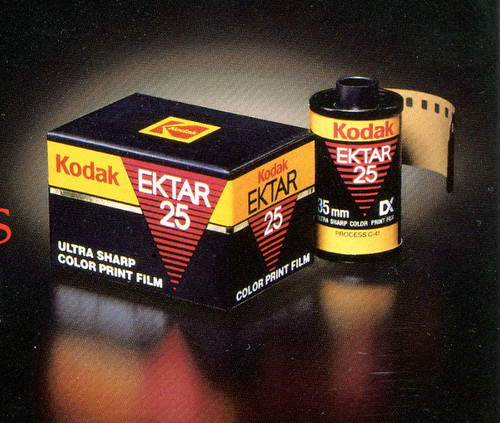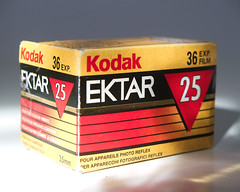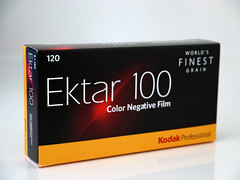Ektar (film)

|
| Ektar 25 advertising image from 1989 scan courtesy Voxphoto image by camerawiki (Image rights) |
Historically, Kodak had used the trademark Ektar for its highest-grade lenses; but at the 1988 Photokina show, the company introduced a new film line consisting of Ektar ISO 25 and ISO 1000 color-print films. These were intended to give the enhanced color saturation and high acutance previously associated with color slide emulsions, and to offer the finest grain possible at their respective film speeds. To achieve these aims, Kodak used its patented T-grain technology, where the silver-halide crystals are grown in flattened, tabular shapes; and the emulsion was coated using fewer, thinner layers to improve resolution.
A 125-speed version of Ektar followed, but this was replaced in 1991 by a reformulated version rated at ISO 100[1]. 35mm Ektar films were discontinued in 1994 with the introduction of the Royal Gold line.
In September 2008[2], Kodak revived the Ektar brand for a new ISO 100 color negative film. As the availability of E-6 slide processing declined, Kodak responded with a more saturated, fine-grained film, designed to use the more widely-available C-41 process. As with other films of the era, the new Ektar was also designed to give good results when scanned. This film earned a generally positive reception, although some found its exposure latitude a bit unforgiving.
It's available in 35 mm, 120 film, and sheets.
Notes
- ↑ "Camera" column by John Durniak, New York Times July 7, 1991.
- ↑ Kodak Professional Ektar 100 Film (archived) at Kodak.com
Sources
- "The Big Show" [reporting on Photokina 1988] "Film Shows Its Stuff:A New Generation of Color Films" December, 1988 Popular Photography (Vol. 95, No. 12; page 92–93).

|
| 1990s packaging image by Best Before1978 (Image rights) |

|
| (2008) Ektar 100 (5 pack, 120 roll film) image by joanseda (Image rights) |